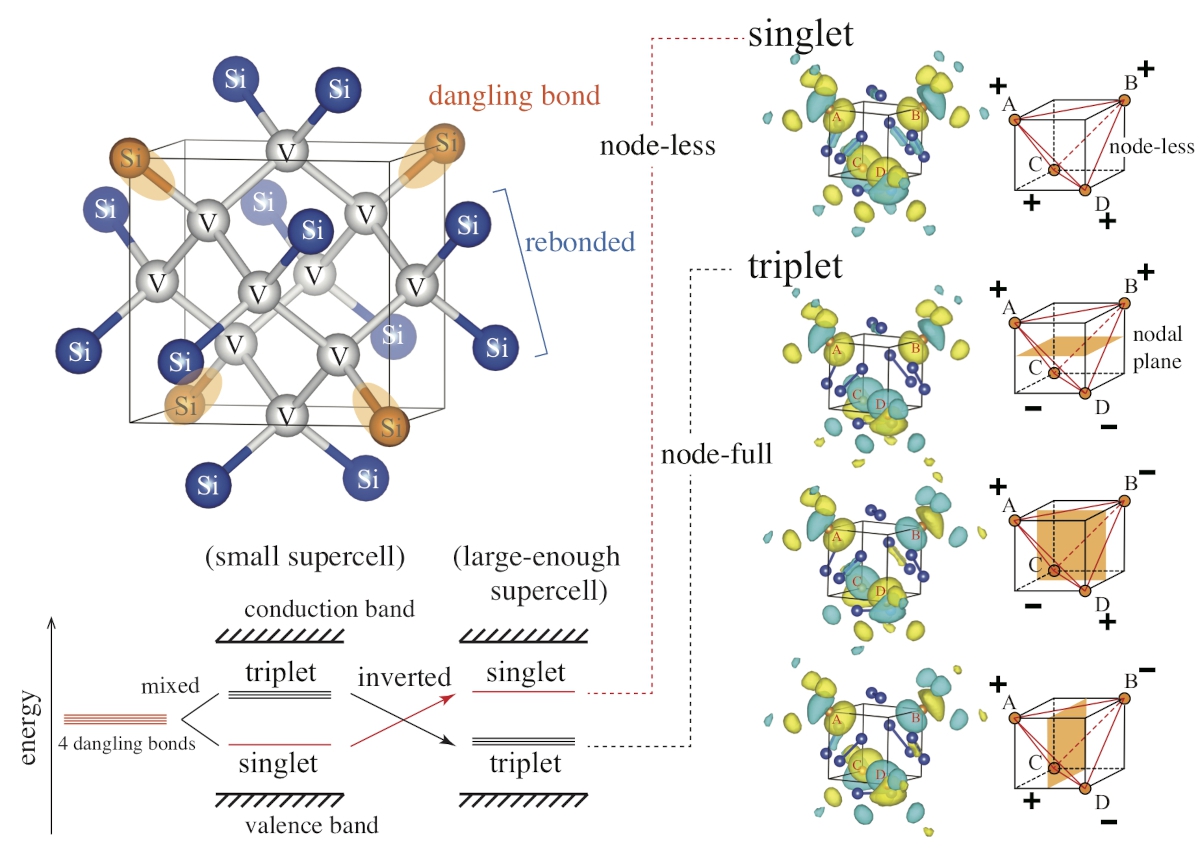Can a Node-Less Wave Function Have Higher Energy than Node-Full Ones?
© The Physical Society of Japan
This article is on
Discovery of Peculiar Electronic Structures of Decavacancy V10 in Silicon Crystal
(JPSJ Editors' Choice)
J. Phys. Soc. Jpn. 91, 064709 (2022).
“The energy level of an electron state increases as the number of nodes in its wave function increases.” The preceding statement, often found in textbooks, was challenged by our large-scale DFT (density-functional theory) calculations performed for the decavacancy in Si crystal.

In quantum mechanics textbooks, a node-less wave function is described as having lower energy than that with nodal planes, because the kinetic energy increases with an increasing number of nodes. This statement has been thought to be universal.
However, we have recently found an exceptional case in the decavacancy of Si crystal, where node-less mixing of four dangling-bond orbitals (φA, φB, φC, and φD) in the singlet state leads to a higher energy than node-full mixing in the triplet states. That is,
where
 (+φA+φB+φC+φD)/2,
(+φA+φB+φC+φD)/2,
 (+φA+φB -φC -φD)/2,
(+φA+φB -φC -φD)/2,
(+φA -φB -φC +φD)/2,
(+φA-φB +φC -φD)/2.
This unexpected energy ordering is the enigma discussed and solved in our study.
Decavacancy V10. is one of the magic number vacancies, obtained by removing a Si10 cluster from an otherwise perfect Si crystal. Although the vacancy is accompanied by 16 dangling bonds, 12 of them are re-bonded with adjacent ones. Thus, we have only four dangling bonds remaining in V10. The four dangling-bond orbitals (φA, φB, φC, and φD) are arranged under the Td symmetry, which mix to generate the singlet and triplet electron states in the band gap, as described by Eq. (2). Our finding in Eq. (1) is surprising, because it seems to contradict a universal rule stated in the textbooks.
To clarify the underlying physics, we constructed a model to reproduce the energy ordering in Eq. (1), and successfully showed that such a non-intuitive electronic structure originates from the slight hybridization of the four dangling-bond states in the band gap with the 12 re-bond states outside the band gap. Here, the “re-bond states” refers to the six bonding states in the valence band and the six anti-bonding states in the conduction band, generated when 12 dangling bonds are paired with adjacent ones. Although such pairing makes the rebond states inactive, we found that the passivation was not perfect. They are slightly hybridized with the four dangling-bond states in the band gap, which make the energy of the node-less singlet higher than that of the node-full triplet.
We argue that this peculiar electronic structure is reflected in the Jahn-Teller instability of the system. We also note that large-scale DFT calculations are paramount for this work, because the supercell size must be large enough for the results of calculations to converge into Eq. (1).
(Written by K. Uchida on behalf of all authors.)
Discovery of Peculiar Electronic Structures of Decavacancy V10 in Silicon Crystal
(JPSJ Editors' Choice)
J. Phys. Soc. Jpn. 91, 064709 (2022).
Share this topic
Fields
Related Articles
-
Which is Moving?—Pinning Down the Origin of Fluctuations in Muon Spin Relaxation—
Structure and mechanical and thermal properties in condensed matter
Cross-disciplinary physics and related areas of science and technology
2024-3-28
The study demonstrated that we can distinguish between the diffusion motion of the muon itself and the motion of the surrounding ions in muon spin relaxation.
-
Variety of Mechanically Induced Spin Currents in Rashba Systems
Electronic transport in condensed matter
Magnetic properties in condensed matter
Structure and mechanical and thermal properties in condensed matter
2024-3-22
Various types of spin currents, including unconventional types, are generated in Rashba spin-orbit coupled systems by dynamic lattice distortions associated with, for example, surface acoustic waves.
-
Relation between Mean-Field Theory and Atomic Structures in Chalcogenide Glasses
Structure and mechanical and thermal properties in condensed matter
2024-2-1
The authors conducted various of X-ray and neutron scattering experiments on typical chalcogenide glasses and clarified the relationship between the atomic structure and simple rigidity percolation theory.
-
Possible Origin of High Thermoelectric Power Factor in Ultrathin FeSe: A Two-band Model
Electronic structure and electrical properties of surfaces and nanostructures
Structure and mechanical and thermal properties in condensed matter
Cross-disciplinary physics and related areas of science and technology
2023-12-21
The high thermoelectric power factor observed in ultrathin FeSe can be theoretically explained by a two-band model with chemical potential between upper and lower band bottoms.
-
Exploring Recent Advances in the Physics of Biofluid Locomotion
Measurement, instrumentation, and techniques
Cross-disciplinary physics and related areas of science and technology
Electromagnetism, optics, acoustics, heat transfer, and classical and fluid mechanics
Statistical physics and thermodynamics
Mathematical methods, classical and quantum physics, relativity, gravitation, numerical simulation, computational modeling
Structure and mechanical and thermal properties in condensed matter
2023-12-8
This Special Topics Edition of the JPSJ describes the latest advances in the field of biofluid locomotion, shedding light on the underlying physics behind the movement of organisms that swim and fly.
